Strategic Management Report: M&S Business Analysis and Strategies
VerifiedAdded on 2020/01/28
|16
|4544
|864
Report
AI Summary
This report provides a detailed strategic analysis of Marks and Spencer (M&S), a prominent British retailer. It begins with an introduction to strategic management and its application to M&S, highlighting the company's strengths and weaknesses. The report then delves into a main analysis section, which includes an environmental audit using SWOT and PESTLE analyses to examine internal and external factors impacting M&S's operations. Porter's Five Forces model is applied to assess the competitive industry landscape. The report further synthesizes ideas and solutions related to strategic issues, analyzes M&S's strategic capabilities, and proposes strategic choices for the company. The analysis covers M&S's market position, its competitive environment, and potential strategies for growth and sustainability, including the adoption of low-cost or differentiation strategies. The report concludes with recommendations and references to support the analysis.
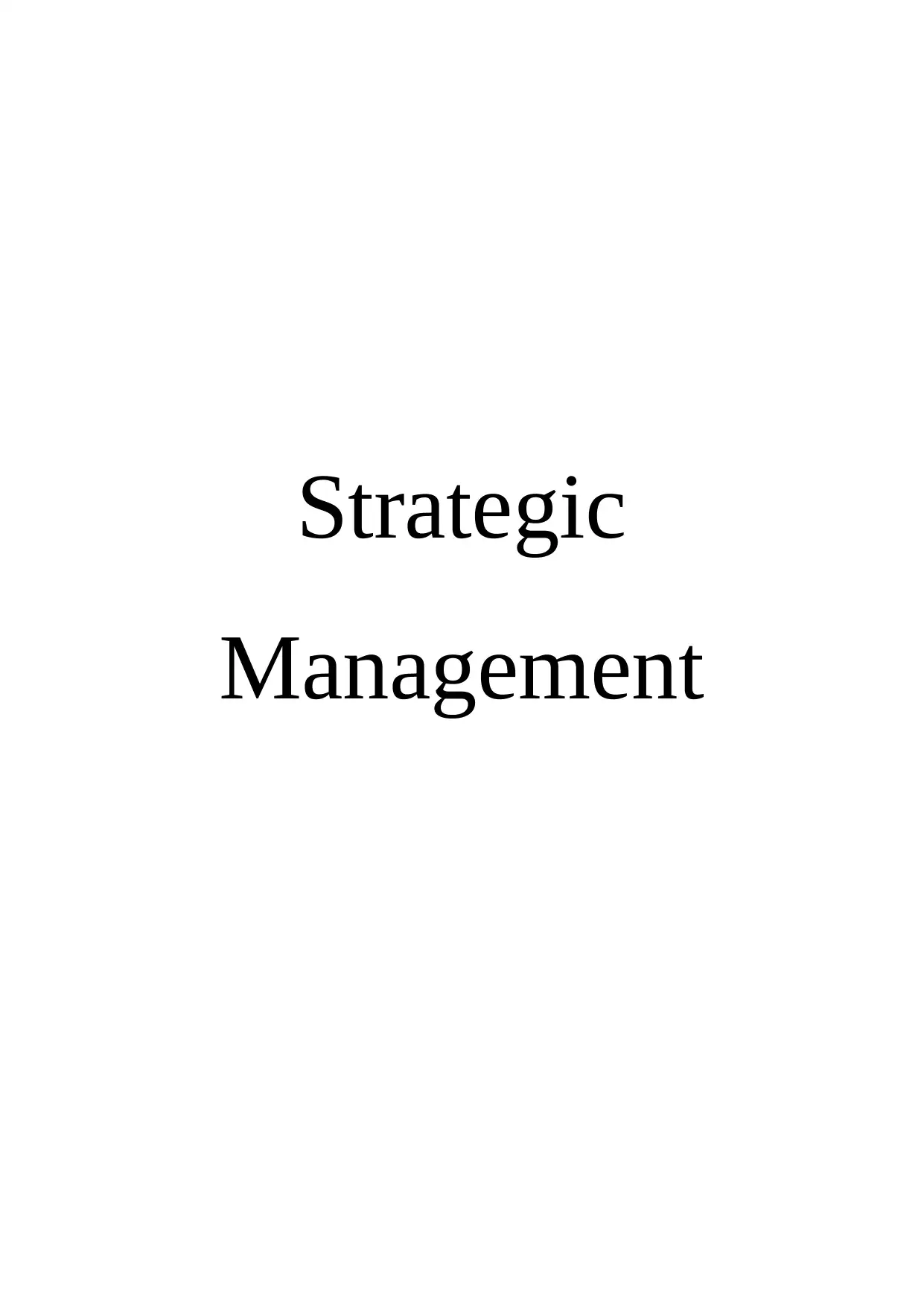
Strategic
Management
Management
Paraphrase This Document
Need a fresh take? Get an instant paraphrase of this document with our AI Paraphraser
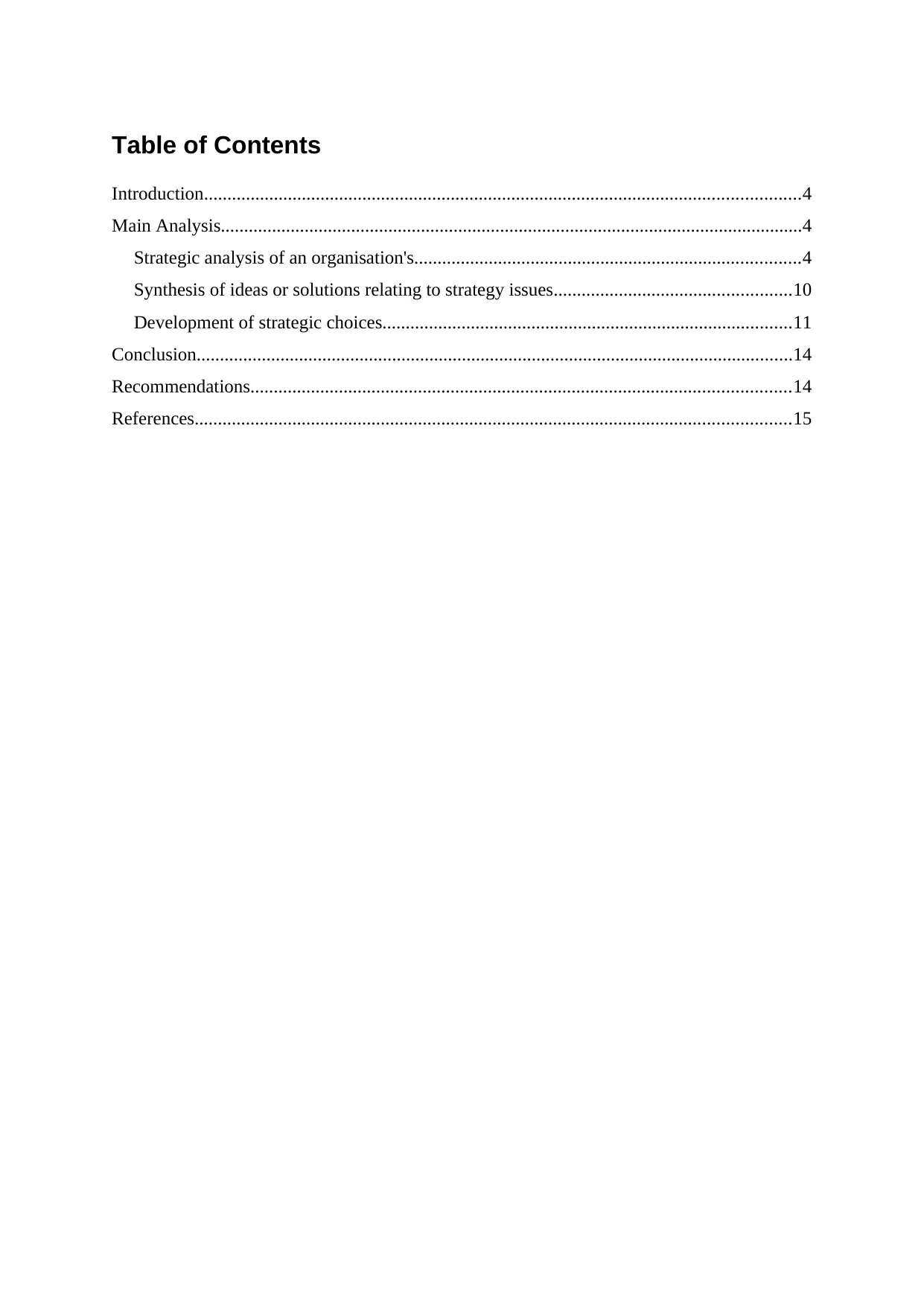
Table of Contents
Introduction................................................................................................................................4
Main Analysis.............................................................................................................................4
Strategic analysis of an organisation's...................................................................................4
Synthesis of ideas or solutions relating to strategy issues...................................................10
Development of strategic choices........................................................................................11
Conclusion................................................................................................................................14
Recommendations....................................................................................................................14
References................................................................................................................................15
Introduction................................................................................................................................4
Main Analysis.............................................................................................................................4
Strategic analysis of an organisation's...................................................................................4
Synthesis of ideas or solutions relating to strategy issues...................................................10
Development of strategic choices........................................................................................11
Conclusion................................................................................................................................14
Recommendations....................................................................................................................14
References................................................................................................................................15
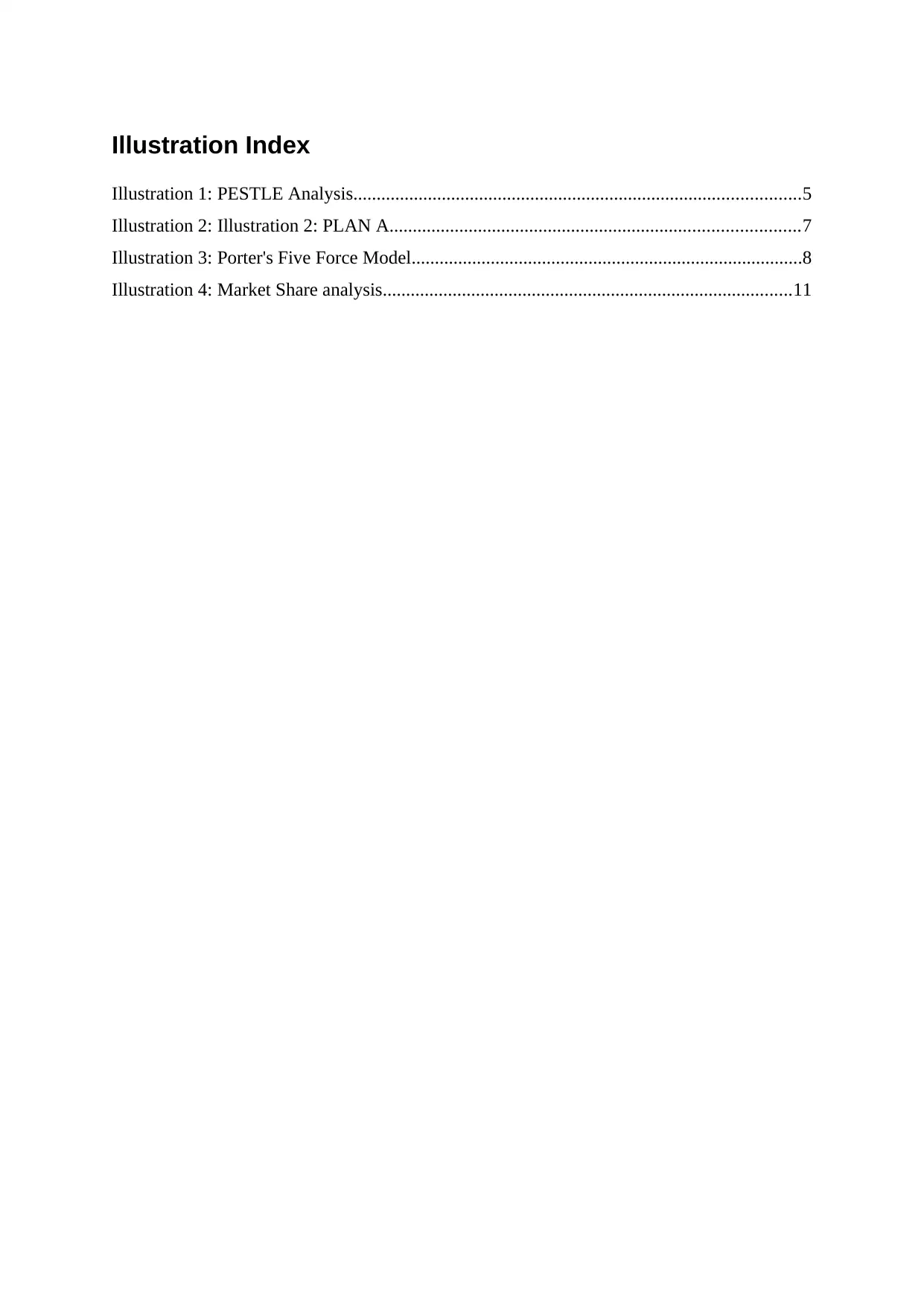
Illustration Index
Illustration 1: PESTLE Analysis................................................................................................5
Illustration 2: Illustration 2: PLAN A........................................................................................7
Illustration 3: Porter's Five Force Model....................................................................................8
Illustration 4: Market Share analysis........................................................................................11
Illustration 1: PESTLE Analysis................................................................................................5
Illustration 2: Illustration 2: PLAN A........................................................................................7
Illustration 3: Porter's Five Force Model....................................................................................8
Illustration 4: Market Share analysis........................................................................................11
⊘ This is a preview!⊘
Do you want full access?
Subscribe today to unlock all pages.

Trusted by 1+ million students worldwide
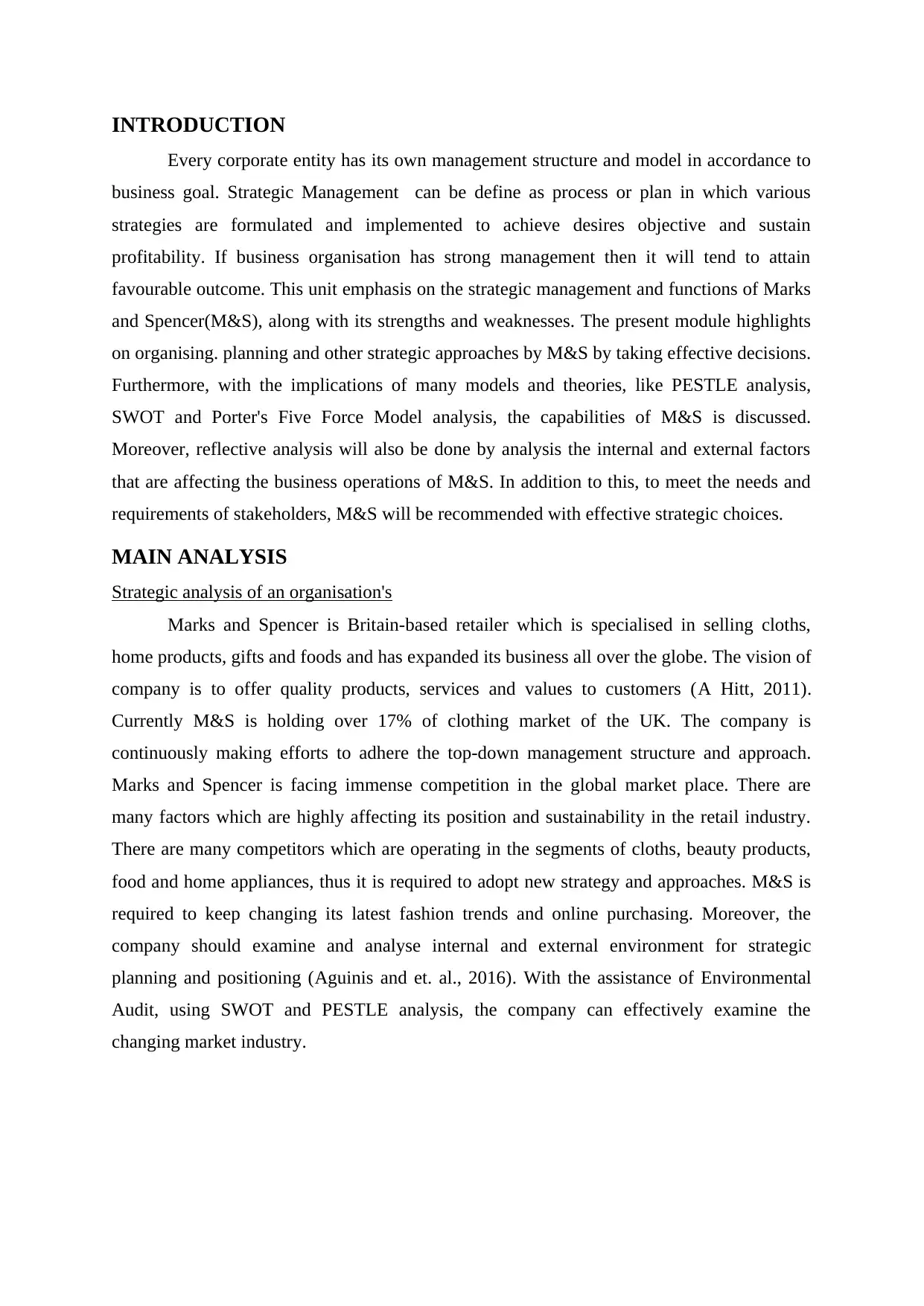
INTRODUCTION
Every corporate entity has its own management structure and model in accordance to
business goal. Strategic Management can be define as process or plan in which various
strategies are formulated and implemented to achieve desires objective and sustain
profitability. If business organisation has strong management then it will tend to attain
favourable outcome. This unit emphasis on the strategic management and functions of Marks
and Spencer(M&S), along with its strengths and weaknesses. The present module highlights
on organising. planning and other strategic approaches by M&S by taking effective decisions.
Furthermore, with the implications of many models and theories, like PESTLE analysis,
SWOT and Porter's Five Force Model analysis, the capabilities of M&S is discussed.
Moreover, reflective analysis will also be done by analysis the internal and external factors
that are affecting the business operations of M&S. In addition to this, to meet the needs and
requirements of stakeholders, M&S will be recommended with effective strategic choices.
MAIN ANALYSIS
Strategic analysis of an organisation's
Marks and Spencer is Britain-based retailer which is specialised in selling cloths,
home products, gifts and foods and has expanded its business all over the globe. The vision of
company is to offer quality products, services and values to customers (A Hitt, 2011).
Currently M&S is holding over 17% of clothing market of the UK. The company is
continuously making efforts to adhere the top-down management structure and approach.
Marks and Spencer is facing immense competition in the global market place. There are
many factors which are highly affecting its position and sustainability in the retail industry.
There are many competitors which are operating in the segments of cloths, beauty products,
food and home appliances, thus it is required to adopt new strategy and approaches. M&S is
required to keep changing its latest fashion trends and online purchasing. Moreover, the
company should examine and analyse internal and external environment for strategic
planning and positioning (Aguinis and et. al., 2016). With the assistance of Environmental
Audit, using SWOT and PESTLE analysis, the company can effectively examine the
changing market industry.
Every corporate entity has its own management structure and model in accordance to
business goal. Strategic Management can be define as process or plan in which various
strategies are formulated and implemented to achieve desires objective and sustain
profitability. If business organisation has strong management then it will tend to attain
favourable outcome. This unit emphasis on the strategic management and functions of Marks
and Spencer(M&S), along with its strengths and weaknesses. The present module highlights
on organising. planning and other strategic approaches by M&S by taking effective decisions.
Furthermore, with the implications of many models and theories, like PESTLE analysis,
SWOT and Porter's Five Force Model analysis, the capabilities of M&S is discussed.
Moreover, reflective analysis will also be done by analysis the internal and external factors
that are affecting the business operations of M&S. In addition to this, to meet the needs and
requirements of stakeholders, M&S will be recommended with effective strategic choices.
MAIN ANALYSIS
Strategic analysis of an organisation's
Marks and Spencer is Britain-based retailer which is specialised in selling cloths,
home products, gifts and foods and has expanded its business all over the globe. The vision of
company is to offer quality products, services and values to customers (A Hitt, 2011).
Currently M&S is holding over 17% of clothing market of the UK. The company is
continuously making efforts to adhere the top-down management structure and approach.
Marks and Spencer is facing immense competition in the global market place. There are
many factors which are highly affecting its position and sustainability in the retail industry.
There are many competitors which are operating in the segments of cloths, beauty products,
food and home appliances, thus it is required to adopt new strategy and approaches. M&S is
required to keep changing its latest fashion trends and online purchasing. Moreover, the
company should examine and analyse internal and external environment for strategic
planning and positioning (Aguinis and et. al., 2016). With the assistance of Environmental
Audit, using SWOT and PESTLE analysis, the company can effectively examine the
changing market industry.
Paraphrase This Document
Need a fresh take? Get an instant paraphrase of this document with our AI Paraphraser
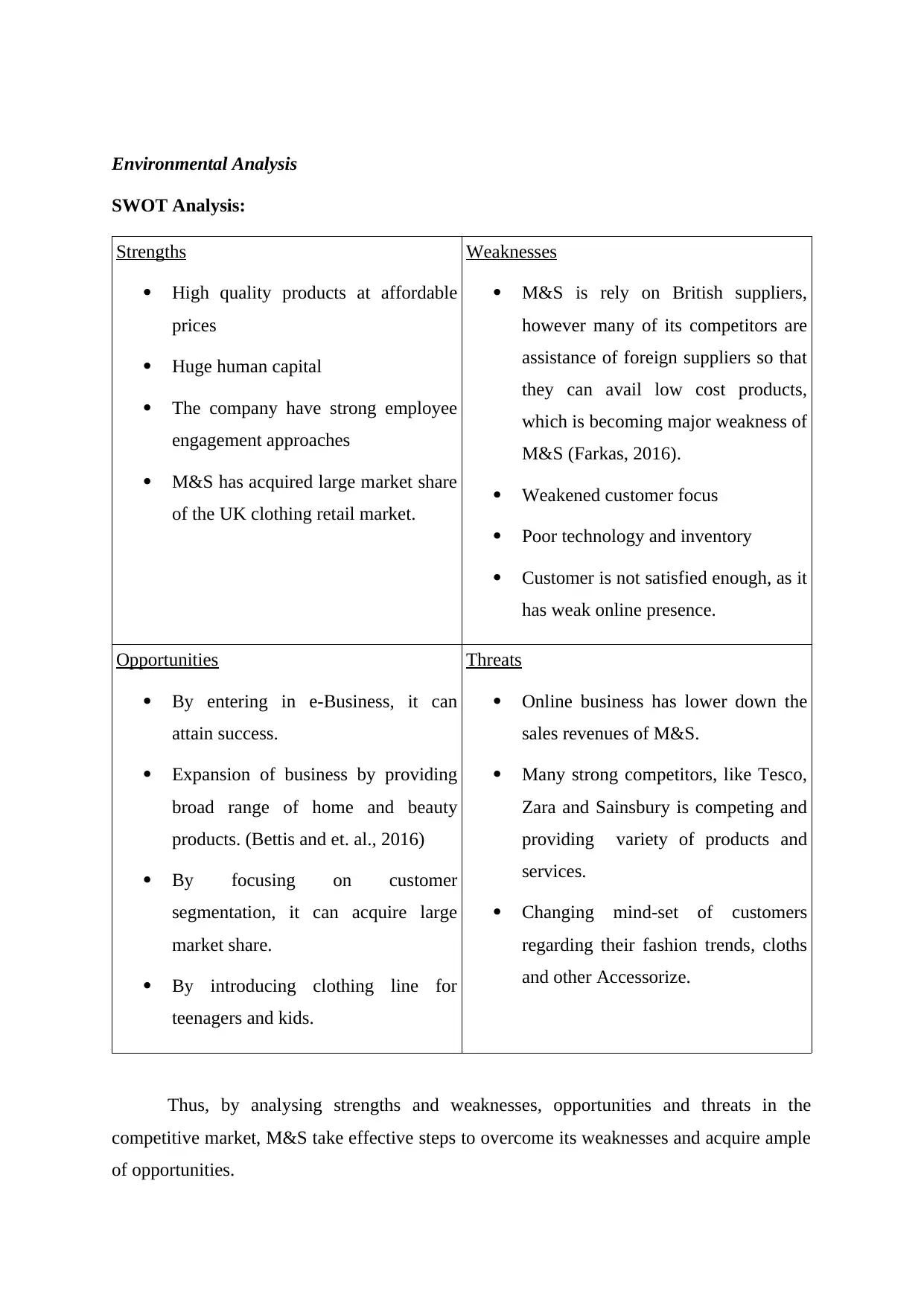
Environmental Analysis
SWOT Analysis:
Strengths
High quality products at affordable
prices
Huge human capital
The company have strong employee
engagement approaches
M&S has acquired large market share
of the UK clothing retail market.
Weaknesses
M&S is rely on British suppliers,
however many of its competitors are
assistance of foreign suppliers so that
they can avail low cost products,
which is becoming major weakness of
M&S (Farkas, 2016).
Weakened customer focus
Poor technology and inventory
Customer is not satisfied enough, as it
has weak online presence.
Opportunities
By entering in e-Business, it can
attain success.
Expansion of business by providing
broad range of home and beauty
products. (Bettis and et. al., 2016)
By focusing on customer
segmentation, it can acquire large
market share.
By introducing clothing line for
teenagers and kids.
Threats
Online business has lower down the
sales revenues of M&S.
Many strong competitors, like Tesco,
Zara and Sainsbury is competing and
providing variety of products and
services.
Changing mind-set of customers
regarding their fashion trends, cloths
and other Accessorize.
Thus, by analysing strengths and weaknesses, opportunities and threats in the
competitive market, M&S take effective steps to overcome its weaknesses and acquire ample
of opportunities.
SWOT Analysis:
Strengths
High quality products at affordable
prices
Huge human capital
The company have strong employee
engagement approaches
M&S has acquired large market share
of the UK clothing retail market.
Weaknesses
M&S is rely on British suppliers,
however many of its competitors are
assistance of foreign suppliers so that
they can avail low cost products,
which is becoming major weakness of
M&S (Farkas, 2016).
Weakened customer focus
Poor technology and inventory
Customer is not satisfied enough, as it
has weak online presence.
Opportunities
By entering in e-Business, it can
attain success.
Expansion of business by providing
broad range of home and beauty
products. (Bettis and et. al., 2016)
By focusing on customer
segmentation, it can acquire large
market share.
By introducing clothing line for
teenagers and kids.
Threats
Online business has lower down the
sales revenues of M&S.
Many strong competitors, like Tesco,
Zara and Sainsbury is competing and
providing variety of products and
services.
Changing mind-set of customers
regarding their fashion trends, cloths
and other Accessorize.
Thus, by analysing strengths and weaknesses, opportunities and threats in the
competitive market, M&S take effective steps to overcome its weaknesses and acquire ample
of opportunities.
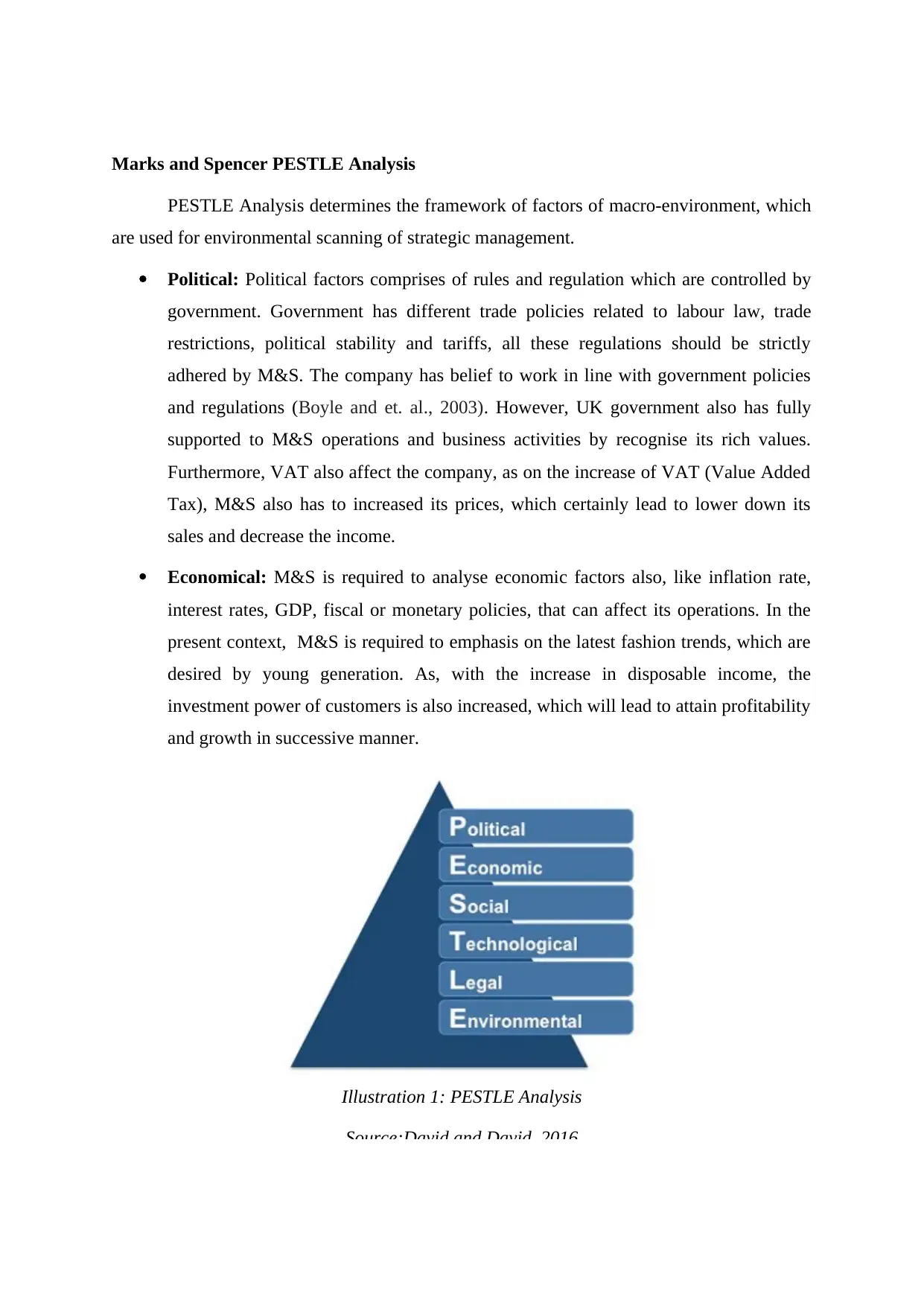
Marks and Spencer PESTLE Analysis
PESTLE Analysis determines the framework of factors of macro-environment, which
are used for environmental scanning of strategic management.
Political: Political factors comprises of rules and regulation which are controlled by
government. Government has different trade policies related to labour law, trade
restrictions, political stability and tariffs, all these regulations should be strictly
adhered by M&S. The company has belief to work in line with government policies
and regulations (Boyle and et. al., 2003). However, UK government also has fully
supported to M&S operations and business activities by recognise its rich values.
Furthermore, VAT also affect the company, as on the increase of VAT (Value Added
Tax), M&S also has to increased its prices, which certainly lead to lower down its
sales and decrease the income.
Economical: M&S is required to analyse economic factors also, like inflation rate,
interest rates, GDP, fiscal or monetary policies, that can affect its operations. In the
present context, M&S is required to emphasis on the latest fashion trends, which are
desired by young generation. As, with the increase in disposable income, the
investment power of customers is also increased, which will lead to attain profitability
and growth in successive manner.
Illustration 1: PESTLE Analysis
Source:David and David, 2016
PESTLE Analysis determines the framework of factors of macro-environment, which
are used for environmental scanning of strategic management.
Political: Political factors comprises of rules and regulation which are controlled by
government. Government has different trade policies related to labour law, trade
restrictions, political stability and tariffs, all these regulations should be strictly
adhered by M&S. The company has belief to work in line with government policies
and regulations (Boyle and et. al., 2003). However, UK government also has fully
supported to M&S operations and business activities by recognise its rich values.
Furthermore, VAT also affect the company, as on the increase of VAT (Value Added
Tax), M&S also has to increased its prices, which certainly lead to lower down its
sales and decrease the income.
Economical: M&S is required to analyse economic factors also, like inflation rate,
interest rates, GDP, fiscal or monetary policies, that can affect its operations. In the
present context, M&S is required to emphasis on the latest fashion trends, which are
desired by young generation. As, with the increase in disposable income, the
investment power of customers is also increased, which will lead to attain profitability
and growth in successive manner.
Illustration 1: PESTLE Analysis
Source:David and David, 2016
⊘ This is a preview!⊘
Do you want full access?
Subscribe today to unlock all pages.

Trusted by 1+ million students worldwide
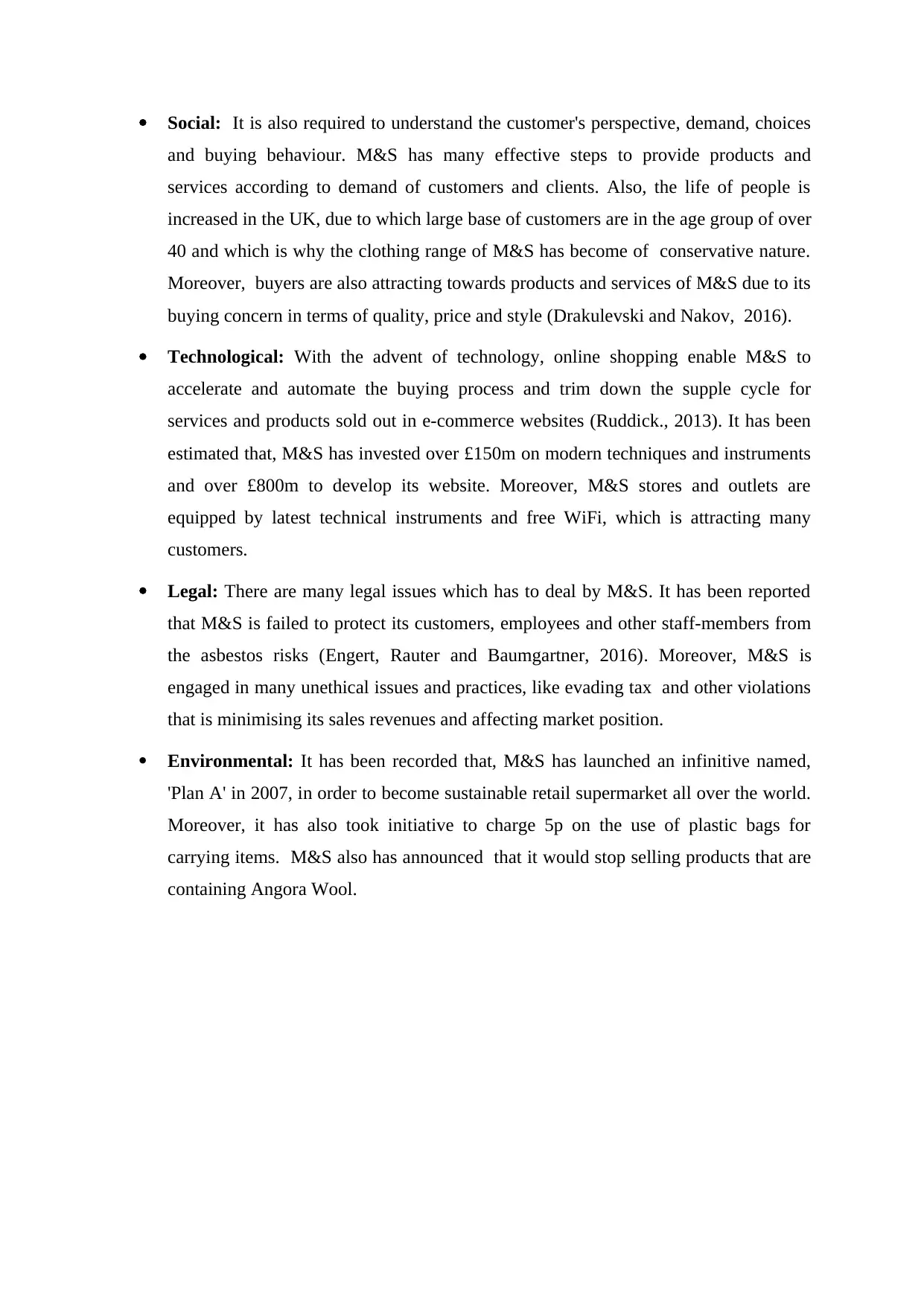
Social: It is also required to understand the customer's perspective, demand, choices
and buying behaviour. M&S has many effective steps to provide products and
services according to demand of customers and clients. Also, the life of people is
increased in the UK, due to which large base of customers are in the age group of over
40 and which is why the clothing range of M&S has become of conservative nature.
Moreover, buyers are also attracting towards products and services of M&S due to its
buying concern in terms of quality, price and style (Drakulevski and Nakov, 2016).
Technological: With the advent of technology, online shopping enable M&S to
accelerate and automate the buying process and trim down the supple cycle for
services and products sold out in e-commerce websites (Ruddick., 2013). It has been
estimated that, M&S has invested over £150m on modern techniques and instruments
and over £800m to develop its website. Moreover, M&S stores and outlets are
equipped by latest technical instruments and free WiFi, which is attracting many
customers.
Legal: There are many legal issues which has to deal by M&S. It has been reported
that M&S is failed to protect its customers, employees and other staff-members from
the asbestos risks (Engert, Rauter and Baumgartner, 2016). Moreover, M&S is
engaged in many unethical issues and practices, like evading tax and other violations
that is minimising its sales revenues and affecting market position.
Environmental: It has been recorded that, M&S has launched an infinitive named,
'Plan A' in 2007, in order to become sustainable retail supermarket all over the world.
Moreover, it has also took initiative to charge 5p on the use of plastic bags for
carrying items. M&S also has announced that it would stop selling products that are
containing Angora Wool.
and buying behaviour. M&S has many effective steps to provide products and
services according to demand of customers and clients. Also, the life of people is
increased in the UK, due to which large base of customers are in the age group of over
40 and which is why the clothing range of M&S has become of conservative nature.
Moreover, buyers are also attracting towards products and services of M&S due to its
buying concern in terms of quality, price and style (Drakulevski and Nakov, 2016).
Technological: With the advent of technology, online shopping enable M&S to
accelerate and automate the buying process and trim down the supple cycle for
services and products sold out in e-commerce websites (Ruddick., 2013). It has been
estimated that, M&S has invested over £150m on modern techniques and instruments
and over £800m to develop its website. Moreover, M&S stores and outlets are
equipped by latest technical instruments and free WiFi, which is attracting many
customers.
Legal: There are many legal issues which has to deal by M&S. It has been reported
that M&S is failed to protect its customers, employees and other staff-members from
the asbestos risks (Engert, Rauter and Baumgartner, 2016). Moreover, M&S is
engaged in many unethical issues and practices, like evading tax and other violations
that is minimising its sales revenues and affecting market position.
Environmental: It has been recorded that, M&S has launched an infinitive named,
'Plan A' in 2007, in order to become sustainable retail supermarket all over the world.
Moreover, it has also took initiative to charge 5p on the use of plastic bags for
carrying items. M&S also has announced that it would stop selling products that are
containing Angora Wool.
Paraphrase This Document
Need a fresh take? Get an instant paraphrase of this document with our AI Paraphraser
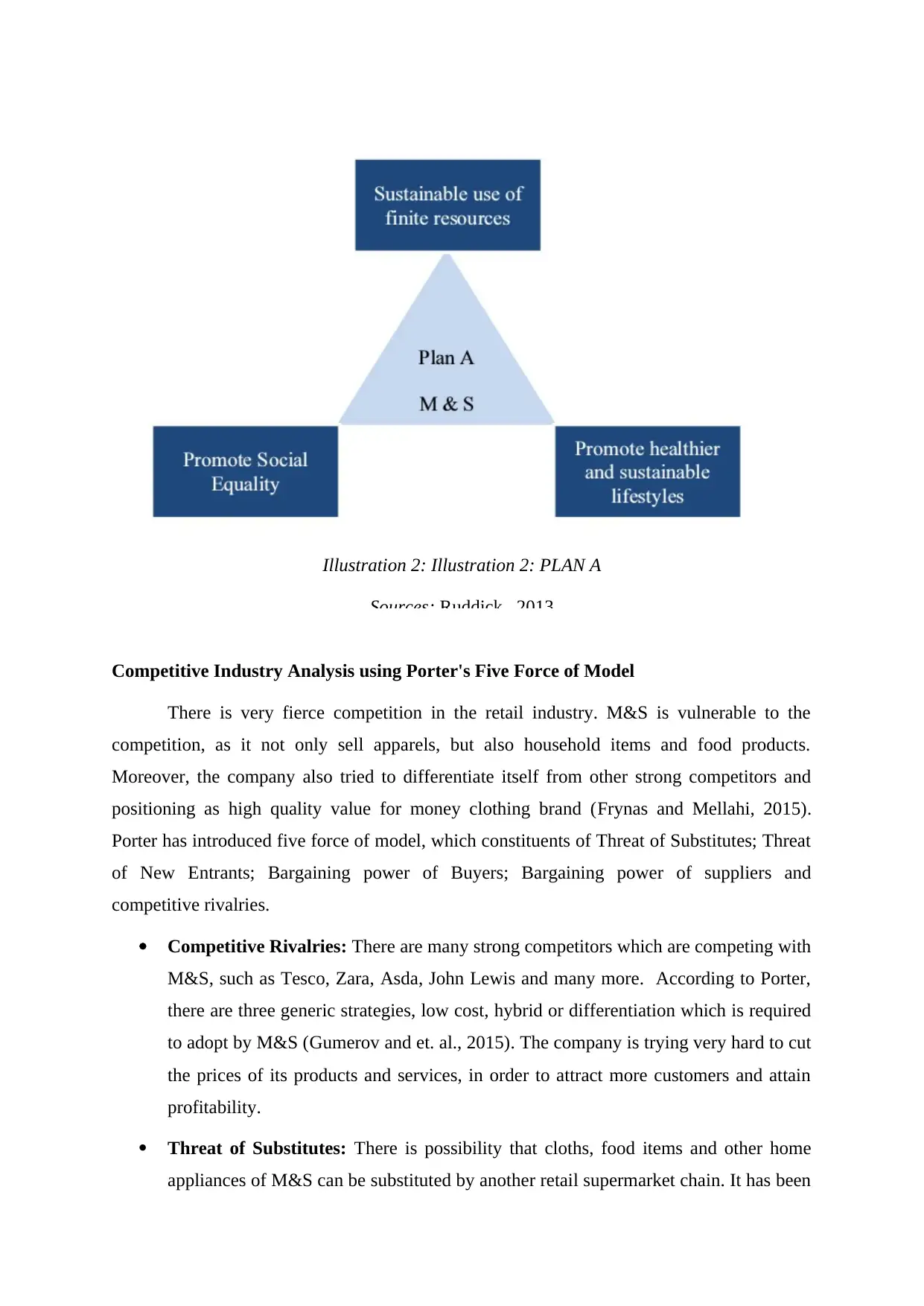
Competitive Industry Analysis using Porter's Five Force of Model
There is very fierce competition in the retail industry. M&S is vulnerable to the
competition, as it not only sell apparels, but also household items and food products.
Moreover, the company also tried to differentiate itself from other strong competitors and
positioning as high quality value for money clothing brand (Frynas and Mellahi, 2015).
Porter has introduced five force of model, which constituents of Threat of Substitutes; Threat
of New Entrants; Bargaining power of Buyers; Bargaining power of suppliers and
competitive rivalries.
Competitive Rivalries: There are many strong competitors which are competing with
M&S, such as Tesco, Zara, Asda, John Lewis and many more. According to Porter,
there are three generic strategies, low cost, hybrid or differentiation which is required
to adopt by M&S (Gumerov and et. al., 2015). The company is trying very hard to cut
the prices of its products and services, in order to attract more customers and attain
profitability.
Threat of Substitutes: There is possibility that cloths, food items and other home
appliances of M&S can be substituted by another retail supermarket chain. It has been
Illustration 2: Illustration 2: PLAN A
Sources: Ruddick., 2013
There is very fierce competition in the retail industry. M&S is vulnerable to the
competition, as it not only sell apparels, but also household items and food products.
Moreover, the company also tried to differentiate itself from other strong competitors and
positioning as high quality value for money clothing brand (Frynas and Mellahi, 2015).
Porter has introduced five force of model, which constituents of Threat of Substitutes; Threat
of New Entrants; Bargaining power of Buyers; Bargaining power of suppliers and
competitive rivalries.
Competitive Rivalries: There are many strong competitors which are competing with
M&S, such as Tesco, Zara, Asda, John Lewis and many more. According to Porter,
there are three generic strategies, low cost, hybrid or differentiation which is required
to adopt by M&S (Gumerov and et. al., 2015). The company is trying very hard to cut
the prices of its products and services, in order to attract more customers and attain
profitability.
Threat of Substitutes: There is possibility that cloths, food items and other home
appliances of M&S can be substituted by another retail supermarket chain. It has been
Illustration 2: Illustration 2: PLAN A
Sources: Ruddick., 2013
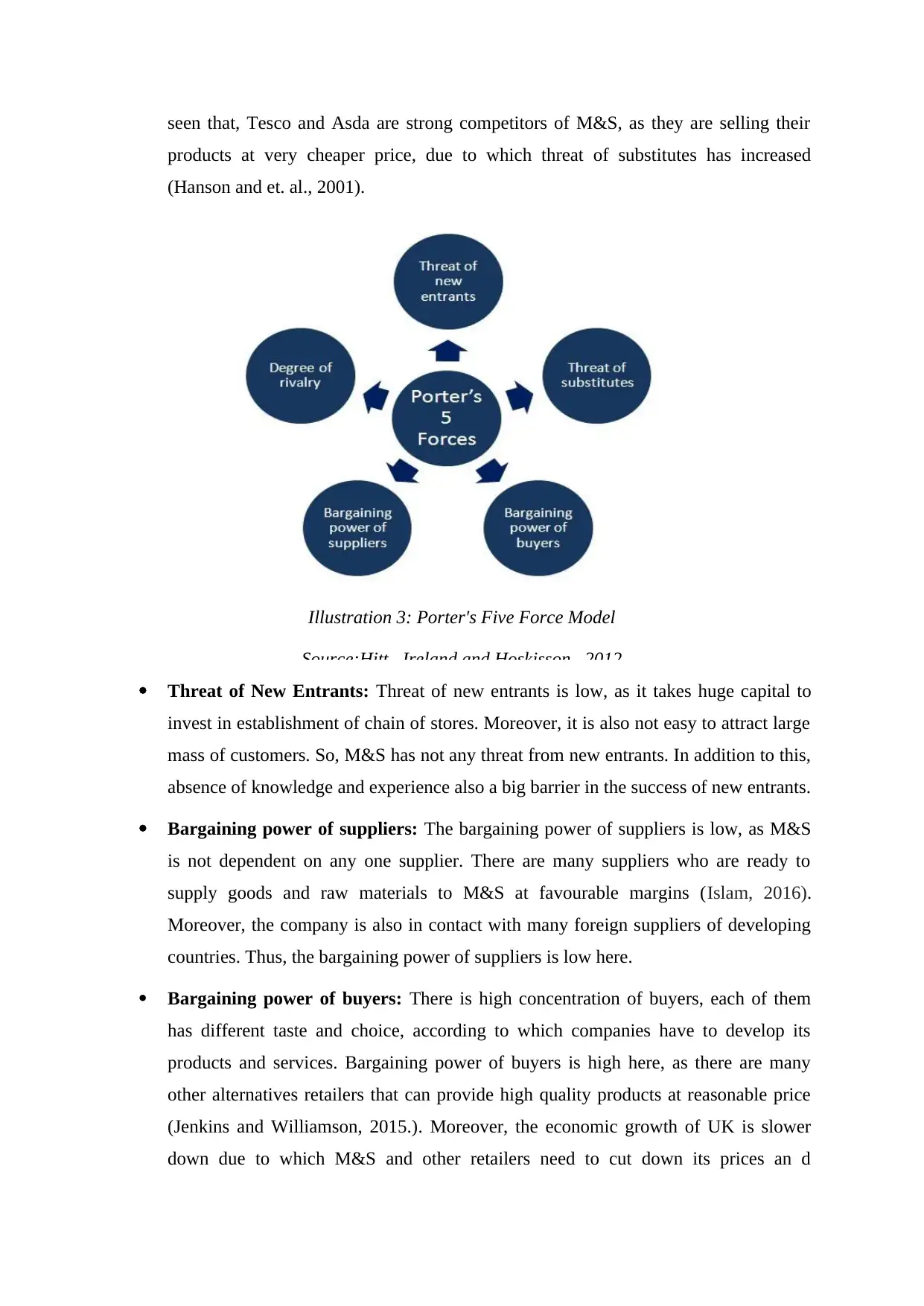
seen that, Tesco and Asda are strong competitors of M&S, as they are selling their
products at very cheaper price, due to which threat of substitutes has increased
(Hanson and et. al., 2001).
Illustration 3: Porter's Five Force Model
Source:Hitt, Ireland and Hoskisson, 2012
Threat of New Entrants: Threat of new entrants is low, as it takes huge capital to
invest in establishment of chain of stores. Moreover, it is also not easy to attract large
mass of customers. So, M&S has not any threat from new entrants. In addition to this,
absence of knowledge and experience also a big barrier in the success of new entrants.
Bargaining power of suppliers: The bargaining power of suppliers is low, as M&S
is not dependent on any one supplier. There are many suppliers who are ready to
supply goods and raw materials to M&S at favourable margins (Islam, 2016).
Moreover, the company is also in contact with many foreign suppliers of developing
countries. Thus, the bargaining power of suppliers is low here.
Bargaining power of buyers: There is high concentration of buyers, each of them
has different taste and choice, according to which companies have to develop its
products and services. Bargaining power of buyers is high here, as there are many
other alternatives retailers that can provide high quality products at reasonable price
(Jenkins and Williamson, 2015.). Moreover, the economic growth of UK is slower
down due to which M&S and other retailers need to cut down its prices an d
products at very cheaper price, due to which threat of substitutes has increased
(Hanson and et. al., 2001).
Illustration 3: Porter's Five Force Model
Source:Hitt, Ireland and Hoskisson, 2012
Threat of New Entrants: Threat of new entrants is low, as it takes huge capital to
invest in establishment of chain of stores. Moreover, it is also not easy to attract large
mass of customers. So, M&S has not any threat from new entrants. In addition to this,
absence of knowledge and experience also a big barrier in the success of new entrants.
Bargaining power of suppliers: The bargaining power of suppliers is low, as M&S
is not dependent on any one supplier. There are many suppliers who are ready to
supply goods and raw materials to M&S at favourable margins (Islam, 2016).
Moreover, the company is also in contact with many foreign suppliers of developing
countries. Thus, the bargaining power of suppliers is low here.
Bargaining power of buyers: There is high concentration of buyers, each of them
has different taste and choice, according to which companies have to develop its
products and services. Bargaining power of buyers is high here, as there are many
other alternatives retailers that can provide high quality products at reasonable price
(Jenkins and Williamson, 2015.). Moreover, the economic growth of UK is slower
down due to which M&S and other retailers need to cut down its prices an d
⊘ This is a preview!⊘
Do you want full access?
Subscribe today to unlock all pages.

Trusted by 1+ million students worldwide
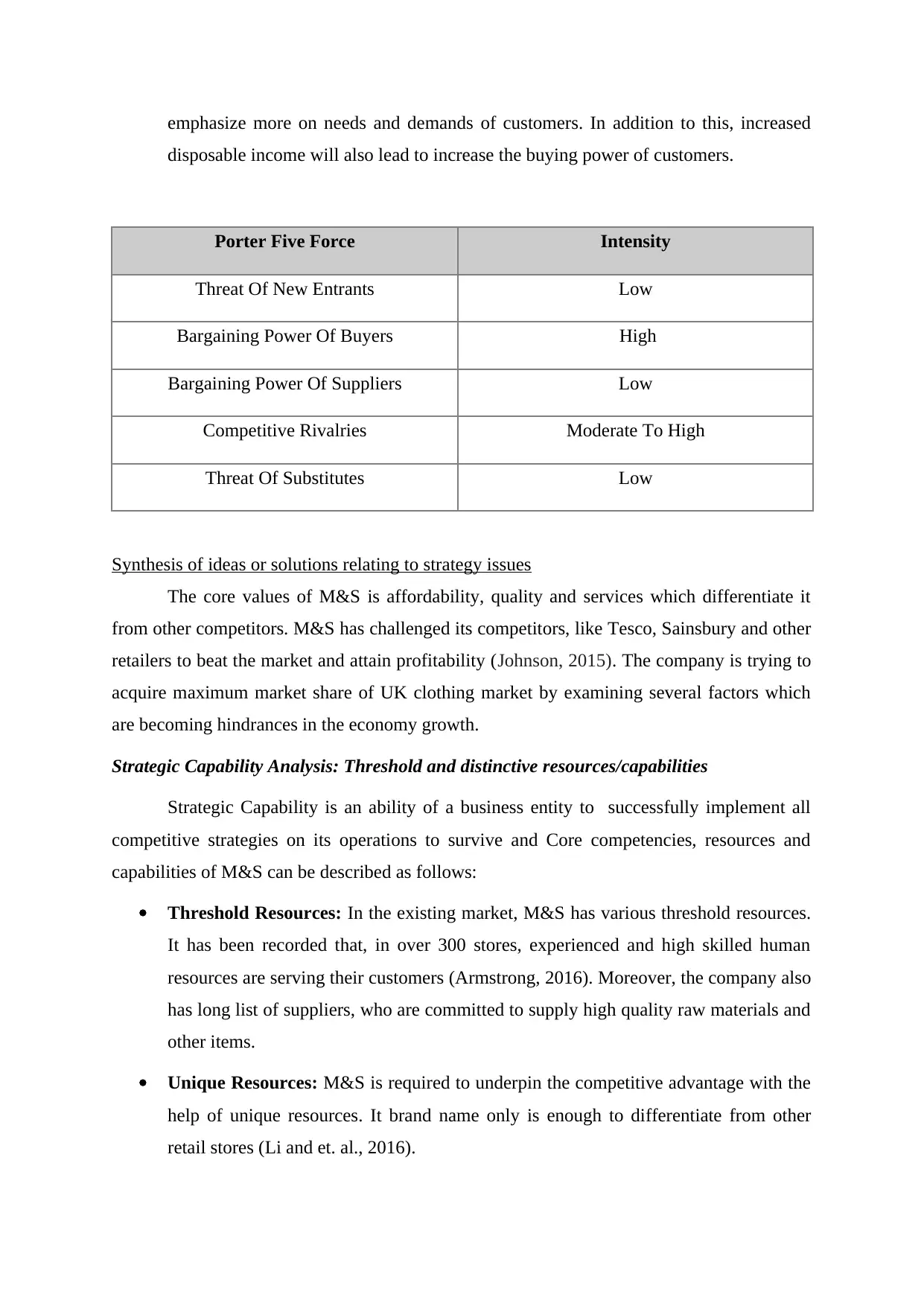
emphasize more on needs and demands of customers. In addition to this, increased
disposable income will also lead to increase the buying power of customers.
Porter Five Force Intensity
Threat Of New Entrants Low
Bargaining Power Of Buyers High
Bargaining Power Of Suppliers Low
Competitive Rivalries Moderate To High
Threat Of Substitutes Low
Synthesis of ideas or solutions relating to strategy issues
The core values of M&S is affordability, quality and services which differentiate it
from other competitors. M&S has challenged its competitors, like Tesco, Sainsbury and other
retailers to beat the market and attain profitability (Johnson, 2015). The company is trying to
acquire maximum market share of UK clothing market by examining several factors which
are becoming hindrances in the economy growth.
Strategic Capability Analysis: Threshold and distinctive resources/capabilities
Strategic Capability is an ability of a business entity to successfully implement all
competitive strategies on its operations to survive and Core competencies, resources and
capabilities of M&S can be described as follows:
Threshold Resources: In the existing market, M&S has various threshold resources.
It has been recorded that, in over 300 stores, experienced and high skilled human
resources are serving their customers (Armstrong, 2016). Moreover, the company also
has long list of suppliers, who are committed to supply high quality raw materials and
other items.
Unique Resources: M&S is required to underpin the competitive advantage with the
help of unique resources. It brand name only is enough to differentiate from other
retail stores (Li and et. al., 2016).
disposable income will also lead to increase the buying power of customers.
Porter Five Force Intensity
Threat Of New Entrants Low
Bargaining Power Of Buyers High
Bargaining Power Of Suppliers Low
Competitive Rivalries Moderate To High
Threat Of Substitutes Low
Synthesis of ideas or solutions relating to strategy issues
The core values of M&S is affordability, quality and services which differentiate it
from other competitors. M&S has challenged its competitors, like Tesco, Sainsbury and other
retailers to beat the market and attain profitability (Johnson, 2015). The company is trying to
acquire maximum market share of UK clothing market by examining several factors which
are becoming hindrances in the economy growth.
Strategic Capability Analysis: Threshold and distinctive resources/capabilities
Strategic Capability is an ability of a business entity to successfully implement all
competitive strategies on its operations to survive and Core competencies, resources and
capabilities of M&S can be described as follows:
Threshold Resources: In the existing market, M&S has various threshold resources.
It has been recorded that, in over 300 stores, experienced and high skilled human
resources are serving their customers (Armstrong, 2016). Moreover, the company also
has long list of suppliers, who are committed to supply high quality raw materials and
other items.
Unique Resources: M&S is required to underpin the competitive advantage with the
help of unique resources. It brand name only is enough to differentiate from other
retail stores (Li and et. al., 2016).
Paraphrase This Document
Need a fresh take? Get an instant paraphrase of this document with our AI Paraphraser
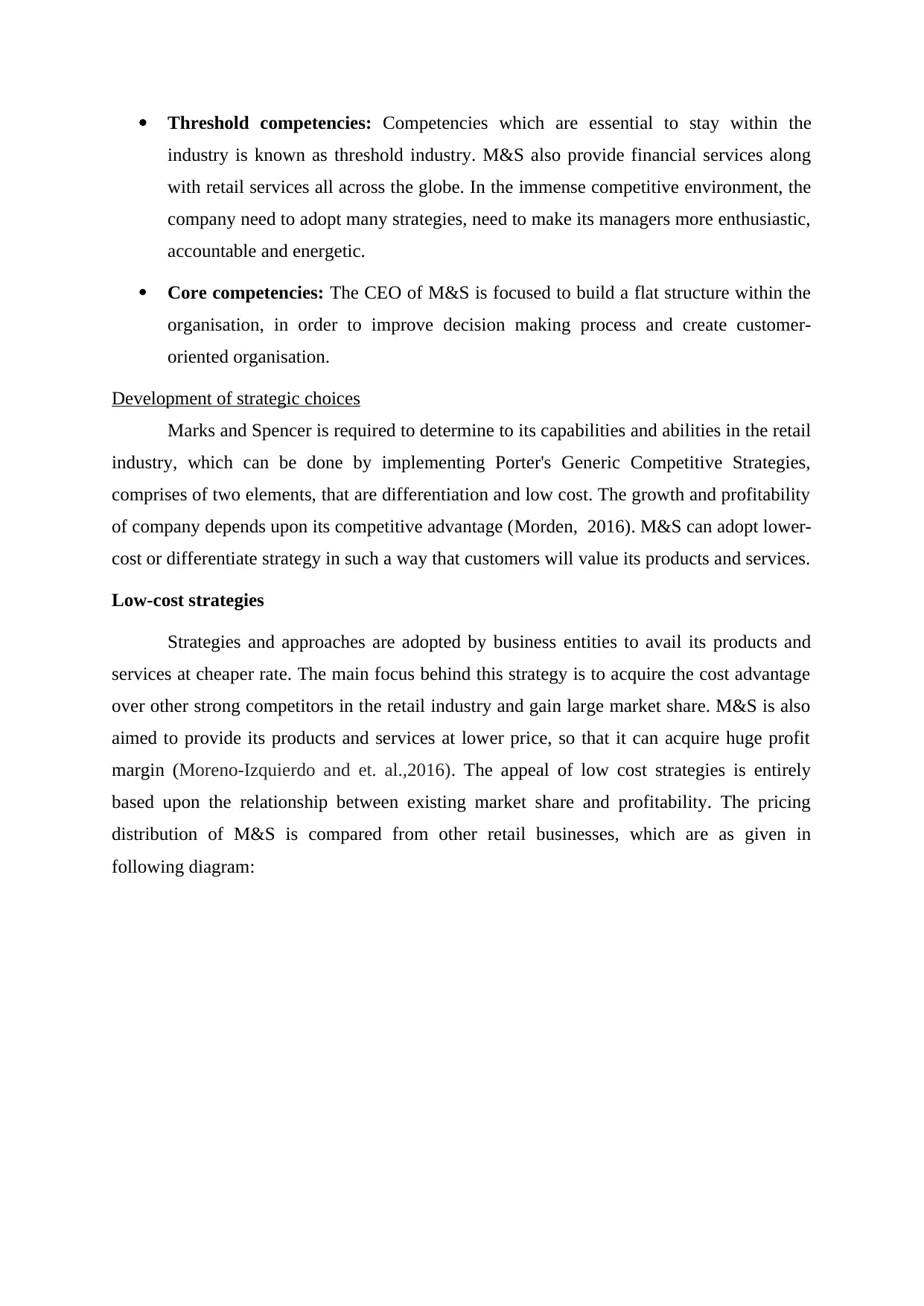
Threshold competencies: Competencies which are essential to stay within the
industry is known as threshold industry. M&S also provide financial services along
with retail services all across the globe. In the immense competitive environment, the
company need to adopt many strategies, need to make its managers more enthusiastic,
accountable and energetic.
Core competencies: The CEO of M&S is focused to build a flat structure within the
organisation, in order to improve decision making process and create customer-
oriented organisation.
Development of strategic choices
Marks and Spencer is required to determine to its capabilities and abilities in the retail
industry, which can be done by implementing Porter's Generic Competitive Strategies,
comprises of two elements, that are differentiation and low cost. The growth and profitability
of company depends upon its competitive advantage (Morden, 2016). M&S can adopt lower-
cost or differentiate strategy in such a way that customers will value its products and services.
Low-cost strategies
Strategies and approaches are adopted by business entities to avail its products and
services at cheaper rate. The main focus behind this strategy is to acquire the cost advantage
over other strong competitors in the retail industry and gain large market share. M&S is also
aimed to provide its products and services at lower price, so that it can acquire huge profit
margin (Moreno-Izquierdo and et. al.,2016). The appeal of low cost strategies is entirely
based upon the relationship between existing market share and profitability. The pricing
distribution of M&S is compared from other retail businesses, which are as given in
following diagram:
industry is known as threshold industry. M&S also provide financial services along
with retail services all across the globe. In the immense competitive environment, the
company need to adopt many strategies, need to make its managers more enthusiastic,
accountable and energetic.
Core competencies: The CEO of M&S is focused to build a flat structure within the
organisation, in order to improve decision making process and create customer-
oriented organisation.
Development of strategic choices
Marks and Spencer is required to determine to its capabilities and abilities in the retail
industry, which can be done by implementing Porter's Generic Competitive Strategies,
comprises of two elements, that are differentiation and low cost. The growth and profitability
of company depends upon its competitive advantage (Morden, 2016). M&S can adopt lower-
cost or differentiate strategy in such a way that customers will value its products and services.
Low-cost strategies
Strategies and approaches are adopted by business entities to avail its products and
services at cheaper rate. The main focus behind this strategy is to acquire the cost advantage
over other strong competitors in the retail industry and gain large market share. M&S is also
aimed to provide its products and services at lower price, so that it can acquire huge profit
margin (Moreno-Izquierdo and et. al.,2016). The appeal of low cost strategies is entirely
based upon the relationship between existing market share and profitability. The pricing
distribution of M&S is compared from other retail businesses, which are as given in
following diagram:
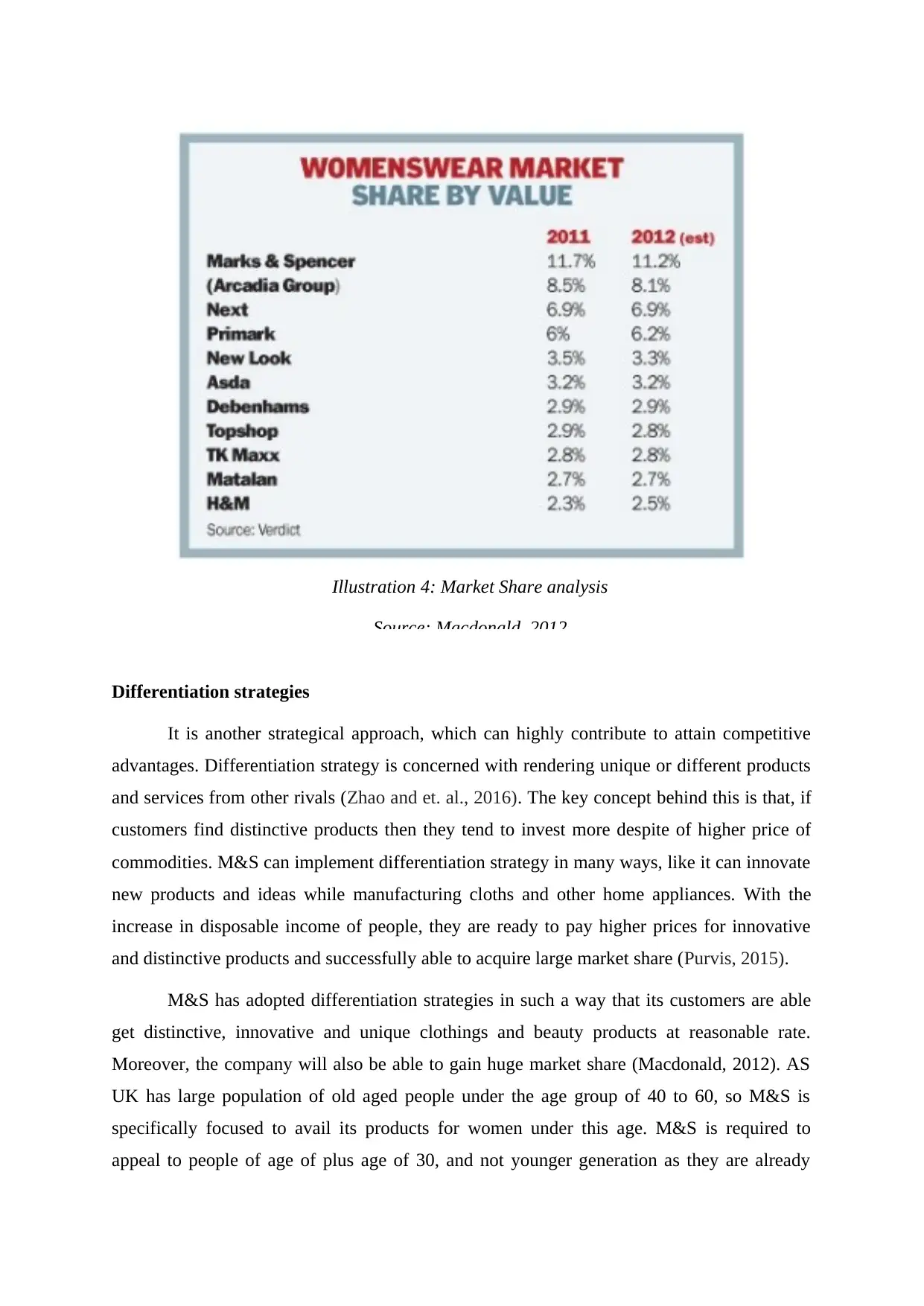
Differentiation strategies
It is another strategical approach, which can highly contribute to attain competitive
advantages. Differentiation strategy is concerned with rendering unique or different products
and services from other rivals (Zhao and et. al., 2016). The key concept behind this is that, if
customers find distinctive products then they tend to invest more despite of higher price of
commodities. M&S can implement differentiation strategy in many ways, like it can innovate
new products and ideas while manufacturing cloths and other home appliances. With the
increase in disposable income of people, they are ready to pay higher prices for innovative
and distinctive products and successfully able to acquire large market share (Purvis, 2015).
M&S has adopted differentiation strategies in such a way that its customers are able
get distinctive, innovative and unique clothings and beauty products at reasonable rate.
Moreover, the company will also be able to gain huge market share (Macdonald, 2012). AS
UK has large population of old aged people under the age group of 40 to 60, so M&S is
specifically focused to avail its products for women under this age. M&S is required to
appeal to people of age of plus age of 30, and not younger generation as they are already
Illustration 4: Market Share analysis
Source: Macdonald, 2012
It is another strategical approach, which can highly contribute to attain competitive
advantages. Differentiation strategy is concerned with rendering unique or different products
and services from other rivals (Zhao and et. al., 2016). The key concept behind this is that, if
customers find distinctive products then they tend to invest more despite of higher price of
commodities. M&S can implement differentiation strategy in many ways, like it can innovate
new products and ideas while manufacturing cloths and other home appliances. With the
increase in disposable income of people, they are ready to pay higher prices for innovative
and distinctive products and successfully able to acquire large market share (Purvis, 2015).
M&S has adopted differentiation strategies in such a way that its customers are able
get distinctive, innovative and unique clothings and beauty products at reasonable rate.
Moreover, the company will also be able to gain huge market share (Macdonald, 2012). AS
UK has large population of old aged people under the age group of 40 to 60, so M&S is
specifically focused to avail its products for women under this age. M&S is required to
appeal to people of age of plus age of 30, and not younger generation as they are already
Illustration 4: Market Share analysis
Source: Macdonald, 2012
⊘ This is a preview!⊘
Do you want full access?
Subscribe today to unlock all pages.

Trusted by 1+ million students worldwide
1 out of 16
Related Documents
Your All-in-One AI-Powered Toolkit for Academic Success.
+13062052269
info@desklib.com
Available 24*7 on WhatsApp / Email
![[object Object]](/_next/static/media/star-bottom.7253800d.svg)
Unlock your academic potential
Copyright © 2020–2025 A2Z Services. All Rights Reserved. Developed and managed by ZUCOL.





